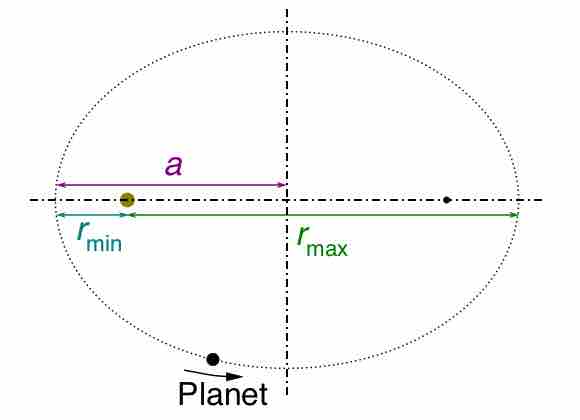Kepler's Third Law
Kepler's third law states:
The square of the orbital period of a planet is directly proportional to the cube of the semi-major axis of its orbit .
The third law, published by Kepler in 1619, captures the relationship between the distance of planets from the Sun, and their orbital periods. Symbolically, the law can be expressed as
where P is the orbital period of the planet and a is the semi-major axis of the orbit (see ).

Kepler's Third Law
Kepler's third law states that the square of the period of the orbit of a planet about the Sun is proportional to the cube of the semi-major axis of the orbit.
The constant of proportionality is
for a sidereal year (yr), and astronomical unit (AU).
Kepler enunciated this third law in a laborious attempt to determine what he viewed as the "music of the spheres" according to precise laws, and express it in terms of musical notation. Therefore, it used to be known as the harmonic law.
Derivation of Kepler's Third Law
We can derive Kepler's third law by starting with Newton's laws of motion and the universal law of gravitation. We can therefore demonstrate that the force of gravity is the cause of Kepler's laws.
Consider a circular orbit of a small mass m around a large mass M. Gravity supplies the centripetal force to mass m. Starting with Newton's second law applied to circular motion,
The net external force on mass m is gravity, and so we substitute the force of gravity for Fnet:
The mass m cancels, as well as an r, yielding
The fact that m cancels out is another aspect of the oft-noted fact that at a given location all masses fall with the same acceleration. Here we see that at a given orbital radius r, all masses orbit at the same speed. This was implied by the result of the preceding worked example. Now, to get at Kepler's third law, we must get the period P into the equation. By definition, period P is the time for one complete orbit. Now the average speed v is the circumference divided by the period—that is,
Substituting this into the previous equation gives
Solving for P2 yields
Using subscripts 1 and 2 to denote two different satellites, and taking the ratio of the last equation for satellite 1 to satellite 2 yields
This is Kepler's third law. Note that Kepler's third law is valid only for comparing satellites of the same parent body, because only then does the mass of the parent body M cancel.
Now consider what one would get when solving P2=4π2GM/r3 for the ratio r3/P2. We obtain a relationship that can be used to determine the mass M of a parent body from the orbits of its satellites:
If r and P are known for a satellite, then the mass M of the parent can be calculated. This principle has been used extensively to find the masses of heavenly bodies that have satellites. Furthermore, the ratio r3/T2 should be a constant for all satellites of the same parent body (because r3/T2=GM/4π2).